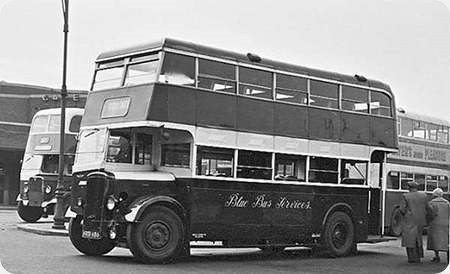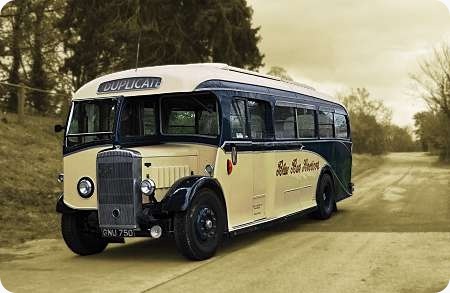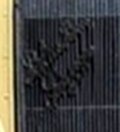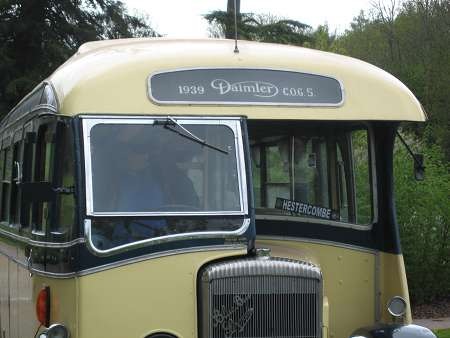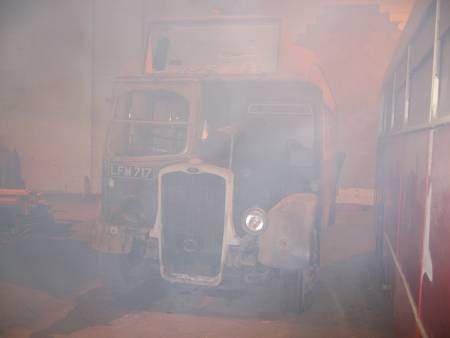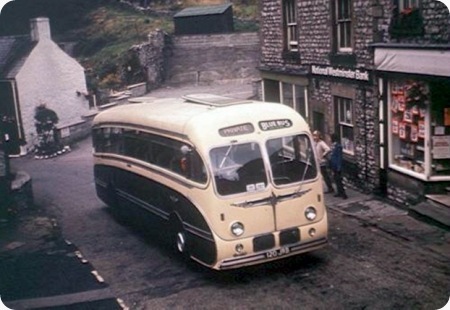
Blue Bus Services
1959
Daimler Freeline CD650H
Burlingham Seagull C37F
The above photograph was given to me by the ex Blue Bus Inspector the late Ken Baker, when I worked for
Derby Borough Transport, and was in charge of the Blue Bus operation at Willington, before the fire.
He had no idea where it was taken, but he thought it was in the Derbyshire Peak District
somewhere, where as I thought it was in Yorkshire. Perhaps somebody will be able to identify the
location?
120 JRB was unusual for a 30ft - long coach in that it was only fitted with 37 seats,
the usual maximum being 41. Contemporary reports state that it was fitted with translucent panelling
which could be lifted for ventilation. It was also fitted with an air operated pre-selector gearbox, and
it was reported that it could travel at 55mph.

This coach was the first vehicle to carry the “Wings” emblem in place of the “Blue Bus Services” fleet
name. If anybody is interested I have a Blue Bus Services page on my website, which can be found at this
link.
I hope someone comes up with the location of 120 JRB.
Photograph and Copy contributed by Stephen Howarth
19/12/11 - 11:06
Good picture, possibly taken in Wirksworth, Derbyshire.
Roger Broughton
19/12/11 - 14:21
You have set us a teaser as to where this is! The pale grey stone suggests
that it is in the southern part of the Peak District- but where is/was there a Natwest Bank?
Wirksworth doesn’t look right on Google Earth- goldish stone & brick- & has a big Natwest: this
is/was a part time branch. I wondered about Youlgreave…..
Joe
19/12/11 - 17:19
Joe, Youlgeave (Pommy) hasn’t had a Natwest Bank, the stone is similar to both
in fact all of the Peak District.
Roger Broughton
20/12/11 - 06:50
Well the few bits that I can add having worked for National Provincial and
later National Westminster Bank are that the picture was taken after February 1971 and the size of
the Branch would suggest that it was an "Agency" open one/two days per week. These were
attached to and run by much larger Branches so that would seem to indicate that it is not too far
from a large town or city. Oh that I had my old Sorting Code book because with a bit of work you
could eliminate possibilities using Google Earth! Sadly, we always had to destroy them.
I’ve
just researched Pateley Bridge because the road layout at the top of the hill is similar but the
Bank is Barclays and too far around the bend. So not much help but any old Yorkshire/Derbyshire
Bankers out there might get closer.
Richard Leaman
20/12/11 - 06:51
A flash of inspiration suggested Bonsall. Have a look at Google maps. I think
the picture was taken from an upstairs window of the Kings Head, looking down Yeoman Street. The end
of the cottage in the distance is fairly distinctive.
Stephen Ford
20/12/11 - 09:29
Well done Stephen- it is indeed: Yeoman St Bonsall. The shops have been
prettified into houses and the bank is no more but looks much the same. The pub car park, probably
once some cottages, has been improved: in fact the whole place looks smarter. It is possible that
the pic was taken from the memorial plinth, but it was probably higher.
I’ll stick to my guns,
though, Roger, on the stone: it was always noticeable that the stone changed going south from
squarish often goldish stones to this pale grey rubbley stuff, often found around those tiny sheep
fields/pens. Compare say Baslow with here.
Joe
20/12/11 - 10:21
I wonder were the coach is heading as the road out of Bonsal towards
Brightgate is very narrow.
Roger Broughton
20/12/11 - 11:24
My guess would be that it was either a trip to view the well-dressings (July)
or a pub visit at the end of an organised sightseeing tour. Roger is right, Bonsall was the end of
the line for buses (and still is). At the time it was North Western territory with a fairly regular
service from Matlock, nowadays G & J Holmes and an hourly service during the day on weekdays.
Stephen Ford
20/12/11 - 12:27
An amazing flash of inspiration, Stephen; I can’t fault it. Think of the
chances that, from such a small group as us, someone would triumph! You shall have a gold star!
Chris Hebbron
20/12/11 - 14:24
O come on, Chris. There’s some shared brain power among us - and we’re
probably all getting on a little bit now!
Coming from the Peak District end of Sheffield, the
whole PD is my (favoured) stomping ground. Now exiled in the south, Bonsall was a regular part of
run out in the car I did when visiting aged (now dead) parents. I only ever went UP hill from
Cromford and never had the perspective of this photo - looking down.
David Oldfield
21/12/11 - 07:21
While it’s true that there are some widely-travelled folk amongst us, it still
surprises me how many questions thrown at the website are answered. I’ll compromise by awarding
Stephen only a silver star, then - okay?
Chris Hebbron
21/12/11 - 07:22
I’ve played around on Streetview, and if you paste this link into your
browser, you can see the scene as it is today when map loades drag and drop the little orange man to
the Kings head at this Google maps link.
KC
21/12/11 - 08:56
Hy Hulley, now there’s a name from the Peak District, nearly had the variety
of vehicles of Barton, some out of COF vehicles would be parked on open land opposite the garage in
Baslow, now luxury flats are parked there ! The business is still operating as Hulley under the
Woolicrofts ownership ex Silver Service of Darley Dale. In the 1978 Busus annual there is a good
article on Peak District operators from the 30’s.
Roger Broughton
21/12/11 - 08:57
Scrooge! I didn’t mean that Stephen didn’t deserve the Gold Star - I’ll
reinstate it and take this opportunity to say Happy Christmas to ALL friends on this wonderful
site.
David Oldfield
21/12/11 - 11:41
………and I’ll second that, a Merry Christmas and a happy New
Year to all.
Chris Hebbron
21/12/11 - 12:03
That must have been one of the last Freelines built - also one of the last
Daimler 10.6 litre engines. Wonder if Blue Bus managed to acquire a stock chassis at a knock down
price for being a loyal Daimler customer? The steering wheel position in the Freeline always looks
too high although presumably the drivers seat was similarly raised to achieve the required min
6"/max 10" clearance between the top of the seat cushion and the underside of the steering
wheel rim required by the Conditions of Fitness Regulations.
Ian Wild
21/12/11 - 13:50
When I said inspiration, I didn’t mean the miraculous sort (or sticking a pin
in a map at random either)! I was just thinking of places I have visited that might fit, then
checking them in Google. Roger mentioned Brightgate just to the north of Bonsall, and we have in
fact camped in a very old static caravan at Brightgate farm a few times. Even in the prettified
state that Joe referred to, Bonsall is a grey village and can look a bit dreary in anything less
than brilliant sunshine. I think my inspiration was along the lines of "it looks grey enough to
be Bonsall!"
Stephen Ford
21/12/11 - 14:55
Stephen, The Barley Mow on the Slaley Rd out of Bonsall is a very good
watering hole which has recently changed hands, good beer and food.
Roger Broughton
22/12/11 - 06:32
It certainly wasn’t one of the last Freelines, I’m not sure when production
officially ceased but Great Yarmouth took some in 1964 with ‘B’ registrations. It would have
been, however, one of the very last Burlingham Seagull’s to the original design. By no means a
unique combination and yes, all of them appeared to have very high steering wheel positions, what is
not immediately apparent is that this one had three long panoramic windows on each side and one
piece windscreens, not the horizontally divided opening type. I think Yelloway had some to this
diagram also. Delivered in June 1959 only just in time for that years summer, I think that was the
last season of this particular shape. If Blue Bus had waited till the following year, they could
have had the Seagull 70 body, now that would have been a unique combination!
Chris Barker
22/12/11 - 06:33
With Streetview you can actually get a link for the exact view you want rather
than the map. Here it is: //g.co/maps/gysy4
Hulleys are indeed still operating, but I’ll have
to look up their history. I think the link with Wooliscroft/Silver Service was short-lived and they
had to be rescued by someone else.
Peter Williamson
22/12/11 - 07:46
If what Chris says is true, then that would indeed make it the Seagull VII and
1959 was about as late as you could get.
I know Hulley’s became independent of Wooliscroft but
have no idea of the eventual (current) ownership. Some hazy reflection puts them back into the
Hulley family but I could never swear to this.
David Oldfield
23/12/11 - 06:52
There is a history of Hulleys on their website
//www.hulleys-of-baslow.co.uk/ which explains everything. The fleet now looks very smart in a
dignified blue and cream livery which was originally inspired by second hand purchases from South
Notts.
Peter Williamson
23/12/11 - 06:53
I am pretty sure the Great Yarmouth Freelines were the last, certainly for the
home market. They were bought while Geoffrey Hilditch was the General Manager, a man who had very
firm ideas on bus purchasing and as an engineer tended to go for high specification designs on the
grounds they gave better pay-back in the long term. He took these principles to Halifax and then
Leicester where he subsequently held the GM posts.
It always seemed strange to me that while
Daimler were very successful with their double deck designs, eg the CVG and the Fleetline, they were
never as successful with single deckers. The Freeline was a well engineered chassis but on the heavy
and expensive side at a time when the industry was moving to lighter weight and lower cost. The
subsequent Roadliner seemed to be a disaster from the start.
Philip Halstead
23/12/11 - 06:55
Premier Travel and Valliant of Ealing were also customers for the Seagull Mk
VII, amongst others. The first Mk VII, on Leyland Tiger Cub chassis, appeared at the 1958 Commercial
Motor Show in Seagull Coaches of Blackpool livery, just like the original Seagull at the 1950 show.
Several of the Valliant examples plus all four Yelloway examples ended up with Premier Travel,
joining the one they bought new, which made Premier Travel the largest operator of the type.
Burlingham’s offering for underfloor engined coaches in 1960 remained the Seagull Mk VII, the
Seagull 70 only appearing for the 1961 season, ie a year later than the similarly styled Seagull 60
for forward engined chassis appeared.
Dave Williamson
23/12/11 - 12:15
I made several journeys in the Gt. Yarmouth Freelines in the early seventies
when they were on hire to Eastern Counties and they were very pleasant vehicles to ride in - a sort
of up market Bristol MW. I believe Yarmouth had a good line in hiring them to coach operators whose
vehicles had broken down in the area.
Nigel Turner
24/12/11 - 06:46
The only time I ever saw the Great Yarmouth Freelines was at Huntingdon St Bus
Station, Nottingham in the mid sixties. One would sometimes appear as a summer Saturday extra on
Trent’s Great Yarmouth service. At this time, Trent often hired in Norfolk Motor Services coaches as
required - presumably the Freeline was part of this arrangement?
Bob Gell
11/08/12 - 07:32
Belated update on 120 JRB (have only just discovered your site) - am most
impressed by how quickly the location of this shot was nailed down, incidentally! Lovely image of
what was - arguably - the final Daimler-engined Freeline (Burwell & District had the other such
chassis that could make the same claim to fame). The lack of window-pillars made quite a visual
difference, certainly in the flesh.
Stephen asks if anyone knows the whereabouts of Dr 18: am
guessing we know of her early years in preservation and subsequent re-emergence in a Barnsley
scrapyard (what DID happen, though?) - since then, Dr 18 has covered quite a few miles, changing
hands along the way several times, until (last I heard) she was in a barn near Uttoxeter with
several other vehicles (so, not far from her Willington home) awaiting her turn for restoration.
Somewhere, I have two or three colour shots of her in this location. If and when I find them, I’ll
scan and submit.
Would LOVE to meet up with Dr 18 again though, so if anyone has more recent
info (I’m going back at least half-a-dozen years, via a contact)…
Clarence
13/10/15 - 06:20
Some 3 years on since the "turn" comment (
11/08/12)
, the vehicle is still in the same shed in the same condition. Would feel
that restoration really quite unlikely now.
Roger Burdett
07/12/15 - 06:15
Freeline 120 JRB is indeed located near Uttoxeter together with CD650 SRB 425
and is owned by Mr Andy Mould. It is indeed the only ‘complete’ surviving Freeline in GB and
is well worthy of restoration. It is mechanically sound but does need a full body restoration. It is
now unique.
Gerald Anthony
02/08/16 - 17:27
How nice to hear this coach has been preserved. The last I heard was that it
was rotting in a scrapyard in the Bradford area.
I was Youth Club Leader at Stretton Church
during the 1960`s (Stretton being on the Blue Bus service route)
We had a"Blackpool
Trip" every year in September and would always ask for this coach known as "Daimler
18" because our coach enthusiasts liked the sound of the powerful Daimler engine and the
hissing of the air operated clutch.
I have a painting of 120 JRB standing outside Repton
Church.
I remember we paid less than £1 per person for the coach (out for 20 hours on a 240
mile round trip) and a ticket to see Cliff Richard in Blackpool plus a tour of the illuminations.
We also asked for "Frank". one of Blue Buses`s young drivers.
Those were the
days !!
Philip Whieldon
 Vehicle reminder shot for this posting
Vehicle reminder shot for this posting
17/08/16 - 09:56
I was kind of hoping you might shed some light on the whole Seagull Mk7
history as I am the owner of Blue Bus Dr18 120 JRB I can find very little other history on this
period of Burlinghams activity and just wondered how many ‘plastic pigs’ were built, the body
panelled entirely in fibreglass providing all the outline with a straight framed body must have been
a brave step and taken a lot of development, although far from their finest hour, having restored
BMS 415 many years ago I can fully appreciate how good they could be and 120 JRB is far from that
build quality even evident after many years.
So I would be keen on know just how many were
built I am aware of 999 EAE was 7 body numbers apart but I am told two of those numbers were
allocated but never used.
Any information would be gratefully received.
Andy Mould
18/08/16 - 06:48
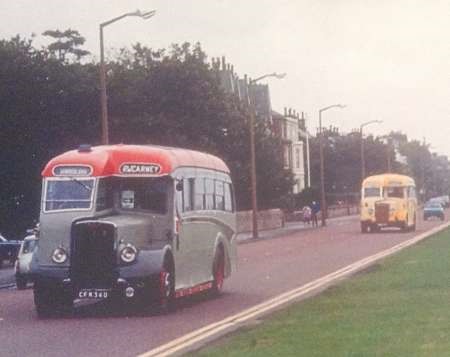
Reference comment of Andy Mould 17/08/16. his restored coach BMS 415.
Behind CFK 340 is BMS 415 returning from Manchester Museum 3rd of April 1982 location of photo
is unknown any detail be gratefully accepted.
Alan Coulson
